-
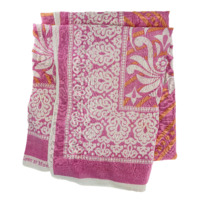 Scarf
Scarf This shawl was worn by Malala Yousafzai on her 16th birthday on 12 July 2013, when she held a speech at the UN Headquarters in New York. Powerfully and persuasively, she conveyed her message – that all children have the right to schooling and education. Books and pencils are the mightiest weapons in the fight against poverty and terrorism.
Even as an eleven-year-old, Malala Yousafzai was campaigning for girls' right to education. When two men affiliated with the Taliban regime tried to kill her in 2012, her fight became internationally famous.
Malala Yousafzai donated the shawl to the Nobel Prize Museum in 2014.
-
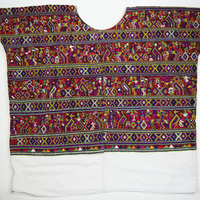 Blouse
Blouse Rigoberta Menchú Tum has received many traditional blouses, “huipil” or “güipil”, as gifts on her visits to different parts of her home country, Guatemala. Menchú Tum has fought for the rights of indigenous people in her country. They belong to the Mayan people, who speak different languages and dialects. Their blouses vary from region to region in Guatemala. This blouse is from the Maya Ixil people in the Ixil region, next to Uspantán, where Rigoberta Menchú Tum was born and grew up. She herself is Maya Quiché.
Rigoberta Menchú Tum donated the blouse to the Nobel Prize Museum in 2014.
-
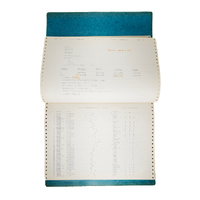 Computer output
Computer output These computer printouts show data and calculations behind a 1981 pioneering study on the rise and fall of share prices by Robert Shiller. In contrast to the dominating idea at the time, he showed that stock prices fluctuated much more than corporate dividends. Shiller’s conclusion was that the market is inefficient.
Robert Shiller donated the computer output to the Nobel Prize Museum in 2014.
-
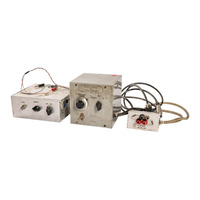 Apparatus
Apparatus These metal boxes contain electronics and have been part of the equipment in Keffer Hartline's laboratory at Johns Hopkins School of Medicine in Baltimore, Maryland. Hartline studied how the signals from photoreceptor cells are processed in networks of neurons. The electronics in the boxes were used to amplify the electrical signals from the neurons. The devices were built by Ted MacNichol, who was Hartline's first graduate student. When the devices were no longer used in the laboratory, Hartline took them home so his sons could use them in school projects.
The apparatus was donated to the Nobel Prize Museum by Keffer Hartline's family in 2014.
-
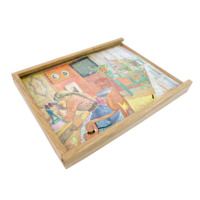 Jigsaw puzzle
Jigsaw puzzle Hugo Theorell made this puzzle at the age of 15 out of a painting by Swedish artist Carl Larsson. At school, Theorell was very interested in woodwork and crafts. Using a jigsaw of his own design, he became skilled at making jigsaw puzzles. By selling them, Theorell paid for violin lessons at home in Linköping and, later, trips to Stockholm for more lessons and other studies. He was a talented violinist, but an even better chemist, receiving the 1955 Medicine Prize for his work on enzymes.
The puzzle was donated to the Nobel Prize Museum by Hugo Theorell’s family in 2014.
-
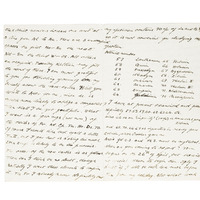 Letter from Henry Moseley to George de Hevesy
Letter from Henry Moseley to George de Hevesy This letter was written in 1914 by the young physicist Henry Moseley to George de Hevesy, who many years later would be awarded the 1943 Nobel Prize in Chemistry. Moseley talks about his investigations of various elements and asks for help in obtaining samples of various elements.
Moseley used X-ray diffraction to study the spectra of different elements and found a relationship between the wavelengths of X-rays and the element's atomic number. This allowed the periodic table to be revised and supplemented.
Moseley's life came to a tragic end when he was killed in the First World War in August 1915. Could his discoveries have resulted in a Nobel Prize? Yes, probably. Svante Arrhenius nominated him for the Nobel Prize in both Physics and Chemistry in 1915. In presenting a later Nobel Prize in a related field, the 1924 physics prize to Manne Siegbahn, Nobel Committee Chairman Allvar Gullstrand said: "Moseley fell at the Dardanelles before he could be awarded the prize... ". Gullstrand said that Moseley's work, however, had drawn the committee's attention to Charles Barkla, who was awarded the 1918 physics prize for his work on the X-ray spectra of atoms.
The letter was presented to the Nobel Prize Museum by the Hevesy family in 2000.
-
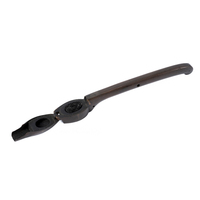 Bläckhus
Bläckhus Werner Forssmann fick någon gång under 1930-talet detta bläckhus av en japansk läkare. Enligt hans dotter var gåvan mycket viktig för honom, annars hade han inte ansträngt sig för att bevara bläckhuset genom de turbulenta åren under andra världskriget.
Bläckhuset donerades till Nobelprismuseet av Werners Forssmanns efterlevande 2014.
-
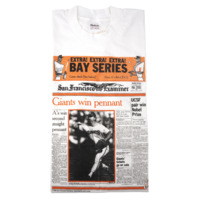 T-shirt
T-shirt T-tröjan visar förstasidan av tidningen San Francisco Examiner den 9 oktober 1989, dagen efter tillkännagivandet av att Michael Bishop tillsammans med Harold Varmus tilldelats Nobelpriset i fysiologi eller medicin. Nyheten om Nobelpriset till de två forskarna vid University of California San Francisco var uppenbarligen en viktig nyhet. Av utrymmet att döma dock inte lika viktig som segrarna för San Francisco Giants och Oakland Athletics i det pågående slutspelet i Major League Baseball.
Michael Bishop donerade tröjan till Nobelprismuseet 2014.
-
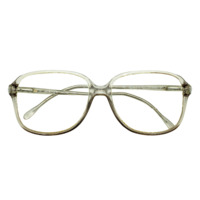 Eyeglasses
Eyeglasses These glasses belonged to Seamus Heaney. They were donated to the Nobel Prize Museum by his wife Marie Devlin, who recalls one occasion when he was wearing them: In October 1995, when he received the phone call informing him that he had won the Nobel Prize in Literature.
The glasses were donated to the Nobel Prize Museum by Marie Devlin in 2014.
-
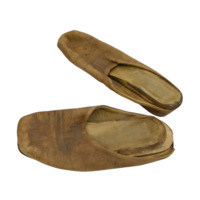 Leather slippers
Leather slippers Tawakkol Karman sees her shoes as a symbol of how she is continuing her fight for democracy and human rights.
Tawakkol Karman donated the shoes to the Nobel Prize Museum in 2014.
-
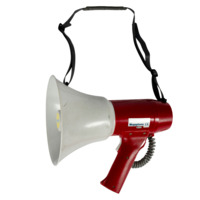 Megaphone
Megaphone This megaphone was the first one Tawakkol Karman used when calling for democracy and human rights. Many protests erupted against incumbent regimes in Arab countries during the Arab Spring in 2011. In the Yemeni capital, Sana'a, journalist and activist Tawakkol Karman led demonstrations against her country's regime. When she donated the megaphone to the Nobel Prize Museum she said: “I would like to give you my voice.”
Tawakkol Karman donated the megaphone to the Nobel Prize Museum in 2014.
-
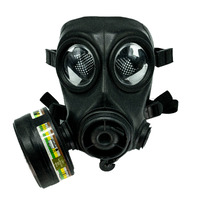 Gas mask
Gas mask A gas mask can provide protection against chemical warfare. The use of chemical weapons has long been banned, but they are still used. Civilians are usually the ones who suffer the most. The Organisation for the Prohibition of Chemical Weapons (OPCW) makes use of international cooperation to help eliminate chemical weapons.
After a visit to the Nobel Prize Museum by the organisation's Director General, Ahmet Üzümcü, the OPCW donated this gas mask to the museum.
OPCW donated the gas mask to the Nobel Prize Museum in 2014.
-
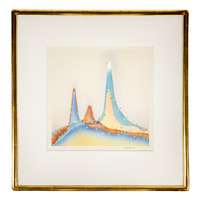 Painting
Painting This painting is an artistic representation of a diagram in a ground-breaking scholarly article by Susumu Tonegawa.
To fight all viruses, bacteria and other damaging substances that we can be exposed to, we need the capacity to produce enormous amounts of different antibodies. The production of antibodies is controlled by genes, but the number of genes is much smaller than the number of antibodies that can be produced. In 1976, Tonegawa showed how this was possible. The genetic material in B cells, a type of white blood cell, can move and form new combinations, while B cells can convert to produce antibodies.
Susumu Tonegawa donated the painting to the Nobel Prize Museum in 2013.
-
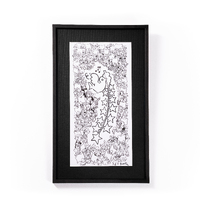 Artwork by Plantu
Artwork by Plantu To commemorate the occasion of being awarded the Nobel Peace Prize, the European Union decided to let make a commemoratory poster. The basis for the poster is artwork by Plantu, Jean Plantureux, a French cartoonist specialized in political satire. The artwork, which is shown here, has as a motif a peace dove with the stars of the EU in its beak, amidst celebration and all the flags of the EU.
The European Union donated the poster to the Nobel Prize Museum in 2013.
-
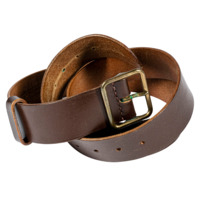 Belt
Belt In his 2002 Nobel Prize lecture, Kurt Wüthrich used his belt to illustrate research on proteins he and his co-laureates had conducted. If the belt represented a polypeptide chain, which forms proteins, then the co-laureates’ work measured the belt’s length. Wüthrich's task was to map the three-dimensional coils of the belt.
Kurt Wüthrich donated the belt to the Nobel Prize Museum in 2013.
-
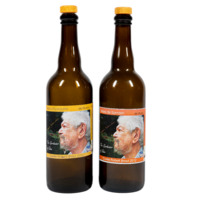 Beer bottles
Beer bottles With two beer bottles, François Englert wanted to pay tribute to his friend and colleague Robert Brout, whose portrait is on the labels of the bottles. The Englert-Brout partnership stretched from 1961 more or less until Brout's death in 2011. In 1964, they co-authored an article that was a decisive step on the road to discovering the Higgs particle. It was not until 2012 that the existence of the Higgs particle could be conclusively proven by an experiment at the CERN laboratory, and Englert and Peter Higgs were jointly awarded the Nobel Prize in Physics the following year.
François Englert donated the bottles to the Nobel Prize Museum in 2013.
-
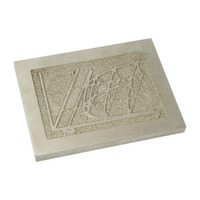 Frisch medal
Frisch medal The Frisch Medal, awarded by the Econometric Society, was named after Ragnar Frisch. For many years, Frisch served as editor of the society's journal and became the first recipient of the Sveriges Riksbank Prize in Economic Sciences in Memory of Alfred Nobel. Lars Peter Hansen was jointly awarded the prize together with Kenneth Singleton in 1984. Hansen donated his medal to the Nobel Prize Museum in 2013.
-
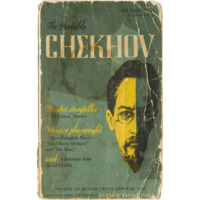 The Portable Chekhov
The Portable Chekhov One of the authors who inspired Alice Munro is Anton Chekhov. For years, Munro has brought a worn paperback edition of some of Chekhov's works, The Portable Chekhov, wherever she went. “It is a very battered copy!”, Munro commented when she donated it to the Nobel Prize Museum in 2013.
-
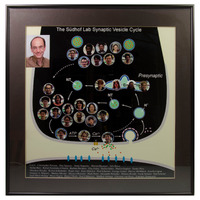 Photographs
Photographs This picture is not just a collection of photographs of members of Thomas Südhof's research team, but also gives an idea of their field of interest: the transportation of various substances inside the cell. Perhaps you could say that this is an image of organic collaboration in research. Thomas Südhof received the picture as a gift from his colleagues and in 2013 he donated it to the Nobel Prize Museum.
-
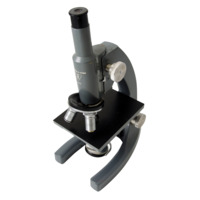 Microscope
Microscope Randy Schekman’s interest in science was sparked early in childhood. When his father explained to 12-year-old Randy that his microscope was only a toy, Randy was very disappointed. To save up for a “real” microscope, Randy ran errands for neighbours and others. His parents borrowed money from Randy's piggy bank to buy groceries, however, and forgot to return it. Randy went to the police station and reported his parents for theft. After receiving a phone call from the police, Randy’s father collected him from the station. On the way home, they stopped to buy this microscope.
Randy Schekman donated the microscope to the Nobel Prize Museum in 2013.
-
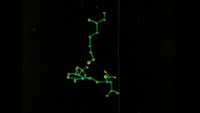 Visualisation of a molecule
Visualisation of a molecule This film shows a simulation of a structural change in a molecule that is vital to vision. The retinal molecule is embedded in the protein rhodopsin, which is found in the light-sensitive rod cells in the retina of the eye. When the molecule absorbs light, one of the atoms in the structure changes position: from a cis form to a trans form. Using computer calculations, Arieh Warshel made simulations of the process. The film based on these simulations was made in 1980.
Arieh Warshel donated the film to the Nobel Prize Museum in 2013.
-
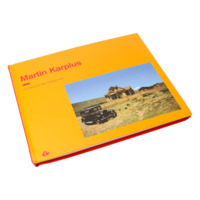 Book with photographs by Martin Karplus
Book with photographs by Martin Karplus This book contains photographs taken by Martin Karplus on his travels in the 1950s. Karplus is a devoted photographer in addition to conducting research into chemical reactions.
Martin Karplus donated the book to the Nobel Prize Museum in 2013.
-
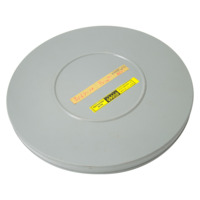 Reel of film
Reel of film This film shows simulations of chemical reactions between a hydrogen atom and a hydrogen molecule, which consists of two hydrogen atoms. The hydrogen molecule splits into two hydrogen atoms, after which one of these forms a new hydrogen molecule with the free hydrogen atom. The simulations were pivotal to Martin Karplus's pioneering work with computer-based methods to simulate the movements and reactions of atoms and molecules under diverse conditions. The film was made in 1967.
Martin Karplus donated the reel of film to the Nobel Prize Museum in 2013.
-
 Gloves
Gloves On September 11, 1916, Robert Bárány received his medal and his diploma, designed by Anna Berglund, from King Gustav V at the Royal Palace. On this occasion he wore these gloves. Bárány had been awarded the Nobel Prize the year before, but no award ceremonies were held during the First World War and Bárány had also been prevented from coming to Stockholm. As a volunteer, he served as a surgeon in the Austrian army on the Eastern Front. In 1915, he was a prisoner of war in Russia when it was announced that he had won the 1914 Nobel Prize in Physiology or Medicine. As a result of negotiations headed by Sweden's Prince Carl on behalf of the Red Cross, he was released in 1916.
The gloves were donated to the Nobel Prize Museum by the Bárány family in 2013.
-
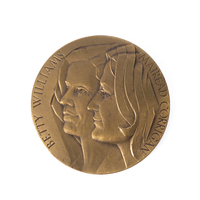 Minnesmedalj
Minnesmedalj Medaljen skapades i samband med att Mairead Corrigan Maguire och Betty Williams tilldelades The Norwegian People’s Peace Prize 1976. Initiativet till priset togs av media i Norge. Mer än 200 000 brittiska pund samlades in. Corrigan och Maguire tilldelades varsin medalj i guld och 5000 kopior präglades. Denna kopia har nummer 2265. Medaljen utformades av Øivind Hansen. Följande år, 1977, tilldelades Corrigan och Williams Nobels fredspris för 1976.
Bakgrunden till Corrigans och Williams engagemang för fred i Nordirland var en händelse i Belfast i augusti 1976. En medlem av Provisoriska IRA (Irländska republikanska armén) blev under bilfärd skjuten till döds av brittisk militär. Bilen körde upp på trottoaren och träffade tre barn som omkom. Williams, som bevittnade olyckan, startade ett upprop för fred och Corrigan, som var barnens moster, anslöt sig till vad som blev en rörelse mot våldet.
Mairead Corrigan Maguire donerade medaljen till Nobelprismuseet 2013.
-
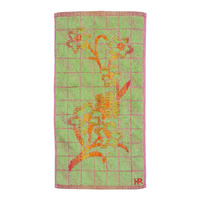 Towel
Towel This towel reminds Shirin Ebadi of her time in prison. The background is that in the wake of the student protests in Iran in 1999, lawyer Shirin Ebadi offered to represent a family whose son had been killed when armed groups cracked down on the protests. In June 2000, she was arrested on charges of having manipulated the filmed testimony of a defector from one of the armed groups. When Ebadi asked to wash herself in the prison, she was denied a towel. She did, however, have just enough money to buy a towel in the prison store. After her release, Ebadi kept the towel as a memento.
Shirin Ebadi donated the towel to the Nobel Prize Museum in 2012.
-
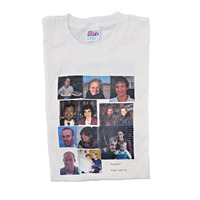 T-shirt
T-shirt This T-shirt has pictures of Alvin Roth's colleagues and was given to him by them.
Alvin Roth donated the T-shirt to the Nobel Prize Museum in 2012.
-
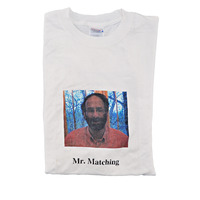 ”Mr Matching” T-shirt
”Mr Matching” T-shirt This T-shirt was given to Alvin Roth by his students. Connecting different agents in the best possible way is central in Roth's Nobel Prize-awarded work. Among other achievements, he has developed a system for matching organ donors with patients in need of transplants. What T-shirt could be more fitting for Roth than one with his portrait and the title "Mr. Matching" printed on the front?
Alvin Roth donated the T-shirt to the Nobel Prize Museum in 2012.
-
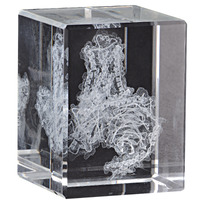 Molecular model etched in glass
Molecular model etched in glass Inside the glass cube is a 3D image portraying an important process that occurs on the surface of our cells: a "receptor" is first activated by the hormone adrenaline, then transmits a signal down inside the cell through a connection to what is known as a G protein. The model was etched in glass in three dimensions. Brian Kobilka and his colleagues created the model after successfully mapping the structure of the linked molecules in 2011.
Brian Kobilka donated the model to the Nobel Prize Museum in 2012.
-
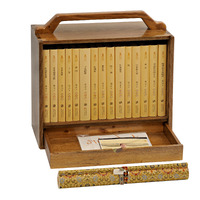 Fifteen books in a wooden case
Fifteen books in a wooden case This ingeniously-designed wooden case with fifteen books contains a collection of Mo Yan's works.
Mo Yan donated the books to the Nobel Prize Museum in 2012.
-
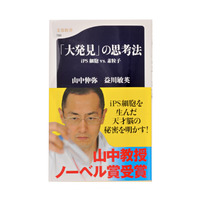 Book
Book This book was written by Shinya Yamanaka, Nobel Prize laureate in physiology or medicine 2012, and Toshihide Masakawa, Nobel Prize laureate in physics 2008.
Shinya Yamanaka donated the book to the Nobel Prize Museum in 2012.
-
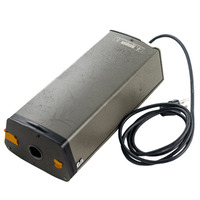 Video camera
Video camera This video camera was used by Steven Chu in a series of experiments where atoms were captured in a trap using laser. Atoms normally move at enormous speed, but Chu developed a method in 1985 for slowing them down with laser beams. When an atom is hit by light particles, photons, with particular energies, this affects its movement, like a shock. With six laser beams arranged two and two in opposite directions, around one million atoms could be captured. They formed a shimmering cloud the size of a pea, and the sequence could be recorded with a video camera.
Steven Chu donated the video camera to the Nobel Prize Museum in 2012.
-
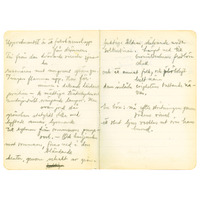 Notebook
Notebook In 1946, when Tomas Tranströmer was fifteen, he began using this notebook. Insects were one of his great interests early in life, and the first page shows a drawing of a beetle. A few years later, in 1951, when he started writing poems, he began to use the notebook again. On the page that is open here is a draft version of the first poem in his debut collection Seventeen Poems from 1954. Tranströmer’s interest in music, which isevident in his poems, is also noticeable in the notebook, in the form of drafts for musical compositions.
Tomas Tranströmer donated the notebook to the Nobel Prize Museum in 2011.
-
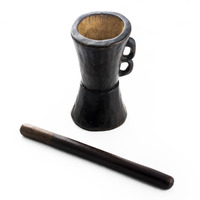 Mortar and pestle
Mortar and pestle As president of Liberia, Ellen Johnson Sirleaf has worked to promote peace, reconciliation and social and economic development. This mortar and pestle was given to her by rural women farmers as a gift.
Ellen Johnson Sirleaf donated the mortar to the Nobel Prize Museum in 2011.
-
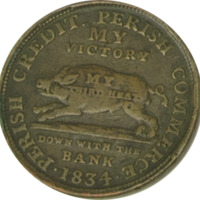 Hard-times token
Hard-times token This token was given to Thomas Sargent by his grandfather and was the key object that sparked his interest in economics. Hard-times tokens were privately issued, unofficial currency. They were issued in the U.S. during the financial and political turmoil of 1833-1843. Hard-times tokens often had a satirical political content. This particular token, issued in 1834, is advocating against President Andrew Jackson. Sargent has subsequently published papers on the history and development of economics in the U.S.
Thomas Sargent donated the token to the Nobel Prize Museum in 2011.
-
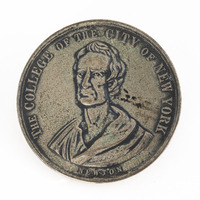 Medal
Medal This medal, the Belden Mathematical Prize, was awarded to Moses Greenfield in 1935, on the occasion of being the second best mathematics student in the New York City public schools. Greenfield is Thomas Sargent’s father-in-law and gave him this medal after they co-authored a research paper in 1993.
Thomas Sargent donated the medal to the Nobel Prize Museum in 2011.
-
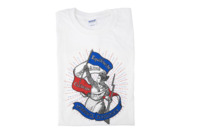 T-shirt
T-shirt This T-shirt is from the Minnesota Economics Department at the University of Minnesota, where Thomas Sargent worked in the 1970s and 1980s. The image is a paraphrase of Eugène Delacroix’s painting "Liberty Leading the People", which celebrates the July Revolution in France in 1830. Instead of the national motto of France, “Liberté, Égalité, Fraternité” (“Liberté, égalité, fraternité”) it says “Equilîbrité, Optimâlité, Calîbrité”, which is faux-french for “Equilbrium, Optimality, Calibration” – key concepts in econometrics.
Thomas Sargent donated the T-shirt to the Nobel Prize Museum in 2011.
-
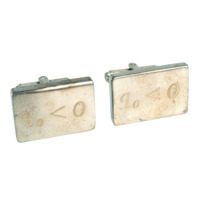 Cufflinks
Cufflinks In the lead-up to the Nobel Prize award ceremony 2011, physics laureate Adam Riess had cufflinks made for himself and the 18 members of his research team.
The cufflinks have a formula, “q0<0”, engraved on them. The meaning of the formula is that our universe is expanding at an ever-increasing rate. This was the discovery that Riess and his co-laureates were awarded the physics prize for.
Riess commissioned the cufflinks seen here before ordering a pair for each researcher. He donated the prototypes to the Nobel Prize Museum 2011.
-
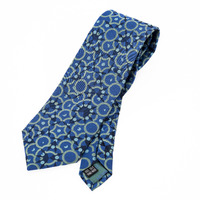 Tie
Tie The pattern on this tie is a quasicrystal, a structure that is ordered but not periodic. Physicists had long agreed that all crystal structures followed a periodic pattern, and , Dan Shechtman met with scepticism in 1982, when he showed that quasicrystals existed. It eventually turned out that he was right, and he was awarded the 2011 Nobel Prize in Chemistry for this discovery. Shechtman received the tie for his 70th birthday from the Technion – Israel Institute of Technology in Haifa, whose vice-chancellor Peretz Lavie had had it custom-made.
Dan Shechtman donated the tie to the Nobel Prize Museum in 2011.
-
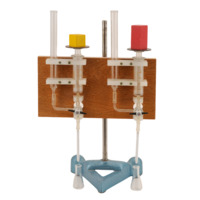 Apparatus
Apparatus Arvid Carlsson and his colleagues designed this device for cleaning tissue extract and isolating dopamine and other substances. Cleaning takes place by pressing the extract through an ion exchange column thatcan take up and bind the dopamine. Thereafter, a liquid is pressed through the column. The liquid releases the dopamine and separates other components. This enables a subsequent determination of the amount of dopamine.
Arvid Carlsson donated the apparatus to the Nobel Prize Museum in 2011.
-
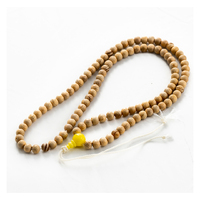 Rosary
Rosary This rosary, a japa mala, is an eastern rosary with 108 beads, used in both Buddhism and Hinduism for counting mantras.
The 14th Dalai Lama donated the rosary to the Nobel Prize Museum in 2011.
-
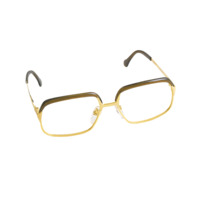 Glasses
Glasses One of the first things you notice about Tenzin Gyatso, the Fourteenth Dalai Lama of Tibet, is his glasses. Does the Dalai Lama see the world differently than we do? For the Dalai Lama, the cultivation of inner peace and integrity is the ultimate means of achieving positive change in an irrational world. Tolerance and understanding are the key components in his world view.
The Dalai Lama donated the glasses to the Nobel Prize Museum in 2011.
-
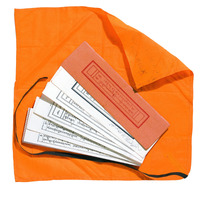 Sutra
Sutra Even today’s world, the Dalai Lama finds wisdom and inspiration in a sutra with old Buddhist texts.
For the Dalai Lama, the cultivation of inner peace and integrity is the ultimate means of achieving positive change in an irrational world. In his Nobel Prize lecture, he said, “Inner peace is the key: if you have inner peace, the external problems do not affect your deep sense of peace and tranquility. In that state of mind, you can deal with situations with calmness and reason, while keeping your inner happiness.”
The 14th Dalai Lama donated the sutra to the Nobel Prize Museum in 2001.
-
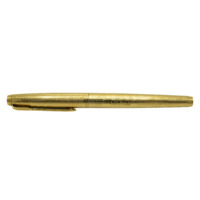 Fountain pen
Fountain pen Pennan har tillhört den 14:e Dalai Lama.
Dalai lama donerade pennan till Nobelprismuseet 2011.
-
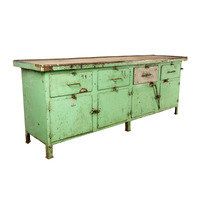 Workbench
Workbench This workbench is from the workshop at the former Lenin Shipyard in Gdansk, where Lech Wałęsa worked as an electrician. The independent trade union Solidarity was established after a major strike in Poland in 1980. Wałęsa was one of its founders and became its leader and spokesperson.
Solidarity was crucial in developments that eventually led to the fall of the communist regimes in Eastern Europe. Wałęsa was elected president of Poland in 1990. The massive weight of the workbench is a reminder of Wałęsa’s background as a worker but also symbolises the force of the upheavals that he helped instigate.
The bench was donated to the Nobel Prize Museum in 2010 by the shipyard in Gdansk in connection with an art installation by Grzegorz Klaman at the museum.
-
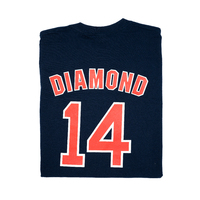 T-shirt
T-shirt T-tröjan utformades av Peter Diamonds doktorander till hans 70-årsdag 2010. Den bär hans namn DIAMOND och heminstitution MIT ECON. Typsnittet är det som används av baseboll-laget Boston Red Sox, som Diamond hängivet hållit på sedan 1949. Som många andra amerikanska pojkar fördjupade han sig i statistik om spelare och matcher, vilket ledde till en hel del huvudräkning. Även senare fick han genom sitt basebollintresse, särskilt genom baseboll-statistikern Bill James analyser, mycket erfarenhet och kunskap om statistiska samband och hur man kan dra slutsatser från tillgänglig information.
I samband med 70-årsdagen ordnade Diamonds fru så att han fick kasta den första pitchen vid en av Boston Red Sox matcher. Många doktorander och lärare vid MIT närvarade iklädda den för Diamond särskilt formgivna tröjan. När Diamond senare samma år utsågs till ekonomipristagare bar många kolleger sina tröjor vid firandet på institutionen.
Peter Diamond donerade tröjan till Nobelprismuseet 2010.
-
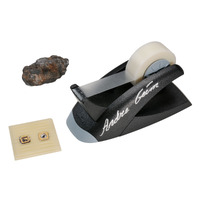 Graphite, tape dispenser and electronic device
Graphite, tape dispenser and electronic device Using ordinary tape and a piece of graphite, Andre Geim and Konstantin Novoselov conducted an experiment with surprising results.
Graphite is a form of carbon that is used in pencils, for example. Physicists had calculated that layers of graphite just one atom thick would have interesting properties, but it was considered impossible to produce in reality. Nevertheless, Geim and Novoselov attempted to separate thin flakes of carbon from a piece of graphite using ordinary tape. Some of these flakes were extremely thin. The new material – “graphene” – had been created.
This device is one of the first where graphene was used.
Andre Geim and Konstantin Novoselov donated the graphite, tape dispenser and electronic device to the Nobel Prize Museum in 2010.
-
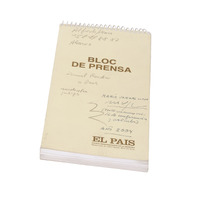 Notepad
Notepad A notepad is often an author’s most important tool. This one originally belonged to Mario Vargas Llosa. It was given to him by El País, Spain’s largest newspaper, to which Vargas Llosa sometimes contributes. Vargas Llosa often takes part in discourse on current issues. He wrote about world events that took place in 2004 in this notepad. Apart from writing, he has also been politically active, running for president in his native Peru in 1990.
Mario Vargas Llosa donated the notepad to the Nobel Prize Museum in 2010.
-
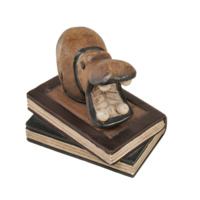 Wooden hippopotamus
Wooden hippopotamus Mario Vargas Llosa has a large collection of hippopotami at home. They even occur in his literary works, as in the play Kathie and the Hippopotamus. Vargas Llosa took a particular liking to a story about a baby hippopotamus that lost its mother when the tsunami hit Kenya in 2004. The baby hippopotamus began searching for a new mother and made an unexpected choice – a 100-year-old tortoise! The tortoise took care of the baby hippo and, when the hippo was fully-grown, it cared for the aged tortoise. Vargas Llosa suggests we should be more like the hippo and the tortoise.
Mario Vargas Llosa donated the hippopotamus to the Nobel Prize Museum in 2010.
-
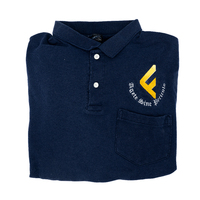 Long Sleeve T-Shirt
Long Sleeve T-Shirt På Oliver Williamsons tröja återfinns ett motto "agete sine periculo", vilket betyder "agera försiktigt".
Oliver Williamson donerade tröjan till Nobelprismuseet 2009.
 Scarf This shawl was worn by Malala Yousafzai on her 16th birthday on 12 July 2013, when she held a speech at the UN Headquarters in New York. Powerfully and persuasively, she conveyed her message – that all children have the right to schooling and education. Books and pencils are the mightiest weapons in the fight against poverty and terrorism. Even as an eleven-year-old, Malala Yousafzai was campaigning for girls' right to education. When two men affiliated with the Taliban regime tried to kill her in 2012, her fight became internationally famous. Malala Yousafzai donated the shawl to the Nobel Prize Museum in 2014.
Scarf This shawl was worn by Malala Yousafzai on her 16th birthday on 12 July 2013, when she held a speech at the UN Headquarters in New York. Powerfully and persuasively, she conveyed her message – that all children have the right to schooling and education. Books and pencils are the mightiest weapons in the fight against poverty and terrorism. Even as an eleven-year-old, Malala Yousafzai was campaigning for girls' right to education. When two men affiliated with the Taliban regime tried to kill her in 2012, her fight became internationally famous. Malala Yousafzai donated the shawl to the Nobel Prize Museum in 2014. Blouse Rigoberta Menchú Tum has received many traditional blouses, “huipil” or “güipil”, as gifts on her visits to different parts of her home country, Guatemala. Menchú Tum has fought for the rights of indigenous people in her country. They belong to the Mayan people, who speak different languages and dialects. Their blouses vary from region to region in Guatemala. This blouse is from the Maya Ixil people in the Ixil region, next to Uspantán, where Rigoberta Menchú Tum was born and grew up. She herself is Maya Quiché. Rigoberta Menchú Tum donated the blouse to the Nobel Prize Museum in 2014.
Blouse Rigoberta Menchú Tum has received many traditional blouses, “huipil” or “güipil”, as gifts on her visits to different parts of her home country, Guatemala. Menchú Tum has fought for the rights of indigenous people in her country. They belong to the Mayan people, who speak different languages and dialects. Their blouses vary from region to region in Guatemala. This blouse is from the Maya Ixil people in the Ixil region, next to Uspantán, where Rigoberta Menchú Tum was born and grew up. She herself is Maya Quiché. Rigoberta Menchú Tum donated the blouse to the Nobel Prize Museum in 2014. Computer output These computer printouts show data and calculations behind a 1981 pioneering study on the rise and fall of share prices by Robert Shiller. In contrast to the dominating idea at the time, he showed that stock prices fluctuated much more than corporate dividends. Shiller’s conclusion was that the market is inefficient. Robert Shiller donated the computer output to the Nobel Prize Museum in 2014.
Computer output These computer printouts show data and calculations behind a 1981 pioneering study on the rise and fall of share prices by Robert Shiller. In contrast to the dominating idea at the time, he showed that stock prices fluctuated much more than corporate dividends. Shiller’s conclusion was that the market is inefficient. Robert Shiller donated the computer output to the Nobel Prize Museum in 2014. Apparatus These metal boxes contain electronics and have been part of the equipment in Keffer Hartline's laboratory at Johns Hopkins School of Medicine in Baltimore, Maryland. Hartline studied how the signals from photoreceptor cells are processed in networks of neurons. The electronics in the boxes were used to amplify the electrical signals from the neurons. The devices were built by Ted MacNichol, who was Hartline's first graduate student. When the devices were no longer used in the laboratory, Hartline took them home so his sons could use them in school projects. The apparatus was donated to the Nobel Prize Museum by Keffer Hartline's family in 2014.
Apparatus These metal boxes contain electronics and have been part of the equipment in Keffer Hartline's laboratory at Johns Hopkins School of Medicine in Baltimore, Maryland. Hartline studied how the signals from photoreceptor cells are processed in networks of neurons. The electronics in the boxes were used to amplify the electrical signals from the neurons. The devices were built by Ted MacNichol, who was Hartline's first graduate student. When the devices were no longer used in the laboratory, Hartline took them home so his sons could use them in school projects. The apparatus was donated to the Nobel Prize Museum by Keffer Hartline's family in 2014. Jigsaw puzzle Hugo Theorell made this puzzle at the age of 15 out of a painting by Swedish artist Carl Larsson. At school, Theorell was very interested in woodwork and crafts. Using a jigsaw of his own design, he became skilled at making jigsaw puzzles. By selling them, Theorell paid for violin lessons at home in Linköping and, later, trips to Stockholm for more lessons and other studies. He was a talented violinist, but an even better chemist, receiving the 1955 Medicine Prize for his work on enzymes. The puzzle was donated to the Nobel Prize Museum by Hugo Theorell’s family in 2014.
Jigsaw puzzle Hugo Theorell made this puzzle at the age of 15 out of a painting by Swedish artist Carl Larsson. At school, Theorell was very interested in woodwork and crafts. Using a jigsaw of his own design, he became skilled at making jigsaw puzzles. By selling them, Theorell paid for violin lessons at home in Linköping and, later, trips to Stockholm for more lessons and other studies. He was a talented violinist, but an even better chemist, receiving the 1955 Medicine Prize for his work on enzymes. The puzzle was donated to the Nobel Prize Museum by Hugo Theorell’s family in 2014. Letter from Henry Moseley to George de Hevesy This letter was written in 1914 by the young physicist Henry Moseley to George de Hevesy, who many years later would be awarded the 1943 Nobel Prize in Chemistry. Moseley talks about his investigations of various elements and asks for help in obtaining samples of various elements. Moseley used X-ray diffraction to study the spectra of different elements and found a relationship between the wavelengths of X-rays and the element's atomic number. This allowed the periodic table to be revised and supplemented. Moseley's life came to a tragic end when he was killed in the First World War in August 1915. Could his discoveries have resulted in a Nobel Prize? Yes, probably. Svante Arrhenius nominated him for the Nobel Prize in both Physics and Chemistry in 1915. In presenting a later Nobel Prize in a related field, the 1924 physics prize to Manne Siegbahn, Nobel Committee Chairman Allvar Gullstrand said: "Moseley fell at the Dardanelles before he could be awarded the prize... ". Gullstrand said that Moseley's work, however, had drawn the committee's attention to Charles Barkla, who was awarded the 1918 physics prize for his work on the X-ray spectra of atoms. The letter was presented to the Nobel Prize Museum by the Hevesy family in 2000.
Letter from Henry Moseley to George de Hevesy This letter was written in 1914 by the young physicist Henry Moseley to George de Hevesy, who many years later would be awarded the 1943 Nobel Prize in Chemistry. Moseley talks about his investigations of various elements and asks for help in obtaining samples of various elements. Moseley used X-ray diffraction to study the spectra of different elements and found a relationship between the wavelengths of X-rays and the element's atomic number. This allowed the periodic table to be revised and supplemented. Moseley's life came to a tragic end when he was killed in the First World War in August 1915. Could his discoveries have resulted in a Nobel Prize? Yes, probably. Svante Arrhenius nominated him for the Nobel Prize in both Physics and Chemistry in 1915. In presenting a later Nobel Prize in a related field, the 1924 physics prize to Manne Siegbahn, Nobel Committee Chairman Allvar Gullstrand said: "Moseley fell at the Dardanelles before he could be awarded the prize... ". Gullstrand said that Moseley's work, however, had drawn the committee's attention to Charles Barkla, who was awarded the 1918 physics prize for his work on the X-ray spectra of atoms. The letter was presented to the Nobel Prize Museum by the Hevesy family in 2000. Bläckhus Werner Forssmann fick någon gång under 1930-talet detta bläckhus av en japansk läkare. Enligt hans dotter var gåvan mycket viktig för honom, annars hade han inte ansträngt sig för att bevara bläckhuset genom de turbulenta åren under andra världskriget. Bläckhuset donerades till Nobelprismuseet av Werners Forssmanns efterlevande 2014.
Bläckhus Werner Forssmann fick någon gång under 1930-talet detta bläckhus av en japansk läkare. Enligt hans dotter var gåvan mycket viktig för honom, annars hade han inte ansträngt sig för att bevara bläckhuset genom de turbulenta åren under andra världskriget. Bläckhuset donerades till Nobelprismuseet av Werners Forssmanns efterlevande 2014. T-shirt T-tröjan visar förstasidan av tidningen San Francisco Examiner den 9 oktober 1989, dagen efter tillkännagivandet av att Michael Bishop tillsammans med Harold Varmus tilldelats Nobelpriset i fysiologi eller medicin. Nyheten om Nobelpriset till de två forskarna vid University of California San Francisco var uppenbarligen en viktig nyhet. Av utrymmet att döma dock inte lika viktig som segrarna för San Francisco Giants och Oakland Athletics i det pågående slutspelet i Major League Baseball. Michael Bishop donerade tröjan till Nobelprismuseet 2014.
T-shirt T-tröjan visar förstasidan av tidningen San Francisco Examiner den 9 oktober 1989, dagen efter tillkännagivandet av att Michael Bishop tillsammans med Harold Varmus tilldelats Nobelpriset i fysiologi eller medicin. Nyheten om Nobelpriset till de två forskarna vid University of California San Francisco var uppenbarligen en viktig nyhet. Av utrymmet att döma dock inte lika viktig som segrarna för San Francisco Giants och Oakland Athletics i det pågående slutspelet i Major League Baseball. Michael Bishop donerade tröjan till Nobelprismuseet 2014. Eyeglasses These glasses belonged to Seamus Heaney. They were donated to the Nobel Prize Museum by his wife Marie Devlin, who recalls one occasion when he was wearing them: In October 1995, when he received the phone call informing him that he had won the Nobel Prize in Literature. The glasses were donated to the Nobel Prize Museum by Marie Devlin in 2014.
Eyeglasses These glasses belonged to Seamus Heaney. They were donated to the Nobel Prize Museum by his wife Marie Devlin, who recalls one occasion when he was wearing them: In October 1995, when he received the phone call informing him that he had won the Nobel Prize in Literature. The glasses were donated to the Nobel Prize Museum by Marie Devlin in 2014. Leather slippers Tawakkol Karman sees her shoes as a symbol of how she is continuing her fight for democracy and human rights. Tawakkol Karman donated the shoes to the Nobel Prize Museum in 2014.
Leather slippers Tawakkol Karman sees her shoes as a symbol of how she is continuing her fight for democracy and human rights. Tawakkol Karman donated the shoes to the Nobel Prize Museum in 2014. Megaphone This megaphone was the first one Tawakkol Karman used when calling for democracy and human rights. Many protests erupted against incumbent regimes in Arab countries during the Arab Spring in 2011. In the Yemeni capital, Sana'a, journalist and activist Tawakkol Karman led demonstrations against her country's regime. When she donated the megaphone to the Nobel Prize Museum she said: “I would like to give you my voice.” Tawakkol Karman donated the megaphone to the Nobel Prize Museum in 2014.
Megaphone This megaphone was the first one Tawakkol Karman used when calling for democracy and human rights. Many protests erupted against incumbent regimes in Arab countries during the Arab Spring in 2011. In the Yemeni capital, Sana'a, journalist and activist Tawakkol Karman led demonstrations against her country's regime. When she donated the megaphone to the Nobel Prize Museum she said: “I would like to give you my voice.” Tawakkol Karman donated the megaphone to the Nobel Prize Museum in 2014. Gas mask A gas mask can provide protection against chemical warfare. The use of chemical weapons has long been banned, but they are still used. Civilians are usually the ones who suffer the most. The Organisation for the Prohibition of Chemical Weapons (OPCW) makes use of international cooperation to help eliminate chemical weapons. After a visit to the Nobel Prize Museum by the organisation's Director General, Ahmet Üzümcü, the OPCW donated this gas mask to the museum. OPCW donated the gas mask to the Nobel Prize Museum in 2014.
Gas mask A gas mask can provide protection against chemical warfare. The use of chemical weapons has long been banned, but they are still used. Civilians are usually the ones who suffer the most. The Organisation for the Prohibition of Chemical Weapons (OPCW) makes use of international cooperation to help eliminate chemical weapons. After a visit to the Nobel Prize Museum by the organisation's Director General, Ahmet Üzümcü, the OPCW donated this gas mask to the museum. OPCW donated the gas mask to the Nobel Prize Museum in 2014. Painting This painting is an artistic representation of a diagram in a ground-breaking scholarly article by Susumu Tonegawa. To fight all viruses, bacteria and other damaging substances that we can be exposed to, we need the capacity to produce enormous amounts of different antibodies. The production of antibodies is controlled by genes, but the number of genes is much smaller than the number of antibodies that can be produced. In 1976, Tonegawa showed how this was possible. The genetic material in B cells, a type of white blood cell, can move and form new combinations, while B cells can convert to produce antibodies. Susumu Tonegawa donated the painting to the Nobel Prize Museum in 2013.
Painting This painting is an artistic representation of a diagram in a ground-breaking scholarly article by Susumu Tonegawa. To fight all viruses, bacteria and other damaging substances that we can be exposed to, we need the capacity to produce enormous amounts of different antibodies. The production of antibodies is controlled by genes, but the number of genes is much smaller than the number of antibodies that can be produced. In 1976, Tonegawa showed how this was possible. The genetic material in B cells, a type of white blood cell, can move and form new combinations, while B cells can convert to produce antibodies. Susumu Tonegawa donated the painting to the Nobel Prize Museum in 2013. Artwork by Plantu To commemorate the occasion of being awarded the Nobel Peace Prize, the European Union decided to let make a commemoratory poster. The basis for the poster is artwork by Plantu, Jean Plantureux, a French cartoonist specialized in political satire. The artwork, which is shown here, has as a motif a peace dove with the stars of the EU in its beak, amidst celebration and all the flags of the EU. The European Union donated the poster to the Nobel Prize Museum in 2013.
Artwork by Plantu To commemorate the occasion of being awarded the Nobel Peace Prize, the European Union decided to let make a commemoratory poster. The basis for the poster is artwork by Plantu, Jean Plantureux, a French cartoonist specialized in political satire. The artwork, which is shown here, has as a motif a peace dove with the stars of the EU in its beak, amidst celebration and all the flags of the EU. The European Union donated the poster to the Nobel Prize Museum in 2013. Belt In his 2002 Nobel Prize lecture, Kurt Wüthrich used his belt to illustrate research on proteins he and his co-laureates had conducted. If the belt represented a polypeptide chain, which forms proteins, then the co-laureates’ work measured the belt’s length. Wüthrich's task was to map the three-dimensional coils of the belt. Kurt Wüthrich donated the belt to the Nobel Prize Museum in 2013.
Belt In his 2002 Nobel Prize lecture, Kurt Wüthrich used his belt to illustrate research on proteins he and his co-laureates had conducted. If the belt represented a polypeptide chain, which forms proteins, then the co-laureates’ work measured the belt’s length. Wüthrich's task was to map the three-dimensional coils of the belt. Kurt Wüthrich donated the belt to the Nobel Prize Museum in 2013. Beer bottles With two beer bottles, François Englert wanted to pay tribute to his friend and colleague Robert Brout, whose portrait is on the labels of the bottles. The Englert-Brout partnership stretched from 1961 more or less until Brout's death in 2011. In 1964, they co-authored an article that was a decisive step on the road to discovering the Higgs particle. It was not until 2012 that the existence of the Higgs particle could be conclusively proven by an experiment at the CERN laboratory, and Englert and Peter Higgs were jointly awarded the Nobel Prize in Physics the following year. François Englert donated the bottles to the Nobel Prize Museum in 2013.
Beer bottles With two beer bottles, François Englert wanted to pay tribute to his friend and colleague Robert Brout, whose portrait is on the labels of the bottles. The Englert-Brout partnership stretched from 1961 more or less until Brout's death in 2011. In 1964, they co-authored an article that was a decisive step on the road to discovering the Higgs particle. It was not until 2012 that the existence of the Higgs particle could be conclusively proven by an experiment at the CERN laboratory, and Englert and Peter Higgs were jointly awarded the Nobel Prize in Physics the following year. François Englert donated the bottles to the Nobel Prize Museum in 2013. Frisch medal The Frisch Medal, awarded by the Econometric Society, was named after Ragnar Frisch. For many years, Frisch served as editor of the society's journal and became the first recipient of the Sveriges Riksbank Prize in Economic Sciences in Memory of Alfred Nobel. Lars Peter Hansen was jointly awarded the prize together with Kenneth Singleton in 1984. Hansen donated his medal to the Nobel Prize Museum in 2013.
Frisch medal The Frisch Medal, awarded by the Econometric Society, was named after Ragnar Frisch. For many years, Frisch served as editor of the society's journal and became the first recipient of the Sveriges Riksbank Prize in Economic Sciences in Memory of Alfred Nobel. Lars Peter Hansen was jointly awarded the prize together with Kenneth Singleton in 1984. Hansen donated his medal to the Nobel Prize Museum in 2013. The Portable Chekhov One of the authors who inspired Alice Munro is Anton Chekhov. For years, Munro has brought a worn paperback edition of some of Chekhov's works, The Portable Chekhov, wherever she went. “It is a very battered copy!”, Munro commented when she donated it to the Nobel Prize Museum in 2013.
The Portable Chekhov One of the authors who inspired Alice Munro is Anton Chekhov. For years, Munro has brought a worn paperback edition of some of Chekhov's works, The Portable Chekhov, wherever she went. “It is a very battered copy!”, Munro commented when she donated it to the Nobel Prize Museum in 2013. Photographs This picture is not just a collection of photographs of members of Thomas Südhof's research team, but also gives an idea of their field of interest: the transportation of various substances inside the cell. Perhaps you could say that this is an image of organic collaboration in research. Thomas Südhof received the picture as a gift from his colleagues and in 2013 he donated it to the Nobel Prize Museum.
Photographs This picture is not just a collection of photographs of members of Thomas Südhof's research team, but also gives an idea of their field of interest: the transportation of various substances inside the cell. Perhaps you could say that this is an image of organic collaboration in research. Thomas Südhof received the picture as a gift from his colleagues and in 2013 he donated it to the Nobel Prize Museum. Microscope Randy Schekman’s interest in science was sparked early in childhood. When his father explained to 12-year-old Randy that his microscope was only a toy, Randy was very disappointed. To save up for a “real” microscope, Randy ran errands for neighbours and others. His parents borrowed money from Randy's piggy bank to buy groceries, however, and forgot to return it. Randy went to the police station and reported his parents for theft. After receiving a phone call from the police, Randy’s father collected him from the station. On the way home, they stopped to buy this microscope. Randy Schekman donated the microscope to the Nobel Prize Museum in 2013.
Microscope Randy Schekman’s interest in science was sparked early in childhood. When his father explained to 12-year-old Randy that his microscope was only a toy, Randy was very disappointed. To save up for a “real” microscope, Randy ran errands for neighbours and others. His parents borrowed money from Randy's piggy bank to buy groceries, however, and forgot to return it. Randy went to the police station and reported his parents for theft. After receiving a phone call from the police, Randy’s father collected him from the station. On the way home, they stopped to buy this microscope. Randy Schekman donated the microscope to the Nobel Prize Museum in 2013. Visualisation of a molecule This film shows a simulation of a structural change in a molecule that is vital to vision. The retinal molecule is embedded in the protein rhodopsin, which is found in the light-sensitive rod cells in the retina of the eye. When the molecule absorbs light, one of the atoms in the structure changes position: from a cis form to a trans form. Using computer calculations, Arieh Warshel made simulations of the process. The film based on these simulations was made in 1980. Arieh Warshel donated the film to the Nobel Prize Museum in 2013.
Visualisation of a molecule This film shows a simulation of a structural change in a molecule that is vital to vision. The retinal molecule is embedded in the protein rhodopsin, which is found in the light-sensitive rod cells in the retina of the eye. When the molecule absorbs light, one of the atoms in the structure changes position: from a cis form to a trans form. Using computer calculations, Arieh Warshel made simulations of the process. The film based on these simulations was made in 1980. Arieh Warshel donated the film to the Nobel Prize Museum in 2013. Book with photographs by Martin Karplus This book contains photographs taken by Martin Karplus on his travels in the 1950s. Karplus is a devoted photographer in addition to conducting research into chemical reactions. Martin Karplus donated the book to the Nobel Prize Museum in 2013.
Book with photographs by Martin Karplus This book contains photographs taken by Martin Karplus on his travels in the 1950s. Karplus is a devoted photographer in addition to conducting research into chemical reactions. Martin Karplus donated the book to the Nobel Prize Museum in 2013. Reel of film This film shows simulations of chemical reactions between a hydrogen atom and a hydrogen molecule, which consists of two hydrogen atoms. The hydrogen molecule splits into two hydrogen atoms, after which one of these forms a new hydrogen molecule with the free hydrogen atom. The simulations were pivotal to Martin Karplus's pioneering work with computer-based methods to simulate the movements and reactions of atoms and molecules under diverse conditions. The film was made in 1967. Martin Karplus donated the reel of film to the Nobel Prize Museum in 2013.
Reel of film This film shows simulations of chemical reactions between a hydrogen atom and a hydrogen molecule, which consists of two hydrogen atoms. The hydrogen molecule splits into two hydrogen atoms, after which one of these forms a new hydrogen molecule with the free hydrogen atom. The simulations were pivotal to Martin Karplus's pioneering work with computer-based methods to simulate the movements and reactions of atoms and molecules under diverse conditions. The film was made in 1967. Martin Karplus donated the reel of film to the Nobel Prize Museum in 2013. Gloves On September 11, 1916, Robert Bárány received his medal and his diploma, designed by Anna Berglund, from King Gustav V at the Royal Palace. On this occasion he wore these gloves. Bárány had been awarded the Nobel Prize the year before, but no award ceremonies were held during the First World War and Bárány had also been prevented from coming to Stockholm. As a volunteer, he served as a surgeon in the Austrian army on the Eastern Front. In 1915, he was a prisoner of war in Russia when it was announced that he had won the 1914 Nobel Prize in Physiology or Medicine. As a result of negotiations headed by Sweden's Prince Carl on behalf of the Red Cross, he was released in 1916. The gloves were donated to the Nobel Prize Museum by the Bárány family in 2013.
Gloves On September 11, 1916, Robert Bárány received his medal and his diploma, designed by Anna Berglund, from King Gustav V at the Royal Palace. On this occasion he wore these gloves. Bárány had been awarded the Nobel Prize the year before, but no award ceremonies were held during the First World War and Bárány had also been prevented from coming to Stockholm. As a volunteer, he served as a surgeon in the Austrian army on the Eastern Front. In 1915, he was a prisoner of war in Russia when it was announced that he had won the 1914 Nobel Prize in Physiology or Medicine. As a result of negotiations headed by Sweden's Prince Carl on behalf of the Red Cross, he was released in 1916. The gloves were donated to the Nobel Prize Museum by the Bárány family in 2013. Minnesmedalj Medaljen skapades i samband med att Mairead Corrigan Maguire och Betty Williams tilldelades The Norwegian People’s Peace Prize 1976. Initiativet till priset togs av media i Norge. Mer än 200 000 brittiska pund samlades in. Corrigan och Maguire tilldelades varsin medalj i guld och 5000 kopior präglades. Denna kopia har nummer 2265. Medaljen utformades av Øivind Hansen. Följande år, 1977, tilldelades Corrigan och Williams Nobels fredspris för 1976. Bakgrunden till Corrigans och Williams engagemang för fred i Nordirland var en händelse i Belfast i augusti 1976. En medlem av Provisoriska IRA (Irländska republikanska armén) blev under bilfärd skjuten till döds av brittisk militär. Bilen körde upp på trottoaren och träffade tre barn som omkom. Williams, som bevittnade olyckan, startade ett upprop för fred och Corrigan, som var barnens moster, anslöt sig till vad som blev en rörelse mot våldet. Mairead Corrigan Maguire donerade medaljen till Nobelprismuseet 2013.
Minnesmedalj Medaljen skapades i samband med att Mairead Corrigan Maguire och Betty Williams tilldelades The Norwegian People’s Peace Prize 1976. Initiativet till priset togs av media i Norge. Mer än 200 000 brittiska pund samlades in. Corrigan och Maguire tilldelades varsin medalj i guld och 5000 kopior präglades. Denna kopia har nummer 2265. Medaljen utformades av Øivind Hansen. Följande år, 1977, tilldelades Corrigan och Williams Nobels fredspris för 1976. Bakgrunden till Corrigans och Williams engagemang för fred i Nordirland var en händelse i Belfast i augusti 1976. En medlem av Provisoriska IRA (Irländska republikanska armén) blev under bilfärd skjuten till döds av brittisk militär. Bilen körde upp på trottoaren och träffade tre barn som omkom. Williams, som bevittnade olyckan, startade ett upprop för fred och Corrigan, som var barnens moster, anslöt sig till vad som blev en rörelse mot våldet. Mairead Corrigan Maguire donerade medaljen till Nobelprismuseet 2013. Towel This towel reminds Shirin Ebadi of her time in prison. The background is that in the wake of the student protests in Iran in 1999, lawyer Shirin Ebadi offered to represent a family whose son had been killed when armed groups cracked down on the protests. In June 2000, she was arrested on charges of having manipulated the filmed testimony of a defector from one of the armed groups. When Ebadi asked to wash herself in the prison, she was denied a towel. She did, however, have just enough money to buy a towel in the prison store. After her release, Ebadi kept the towel as a memento. Shirin Ebadi donated the towel to the Nobel Prize Museum in 2012.
Towel This towel reminds Shirin Ebadi of her time in prison. The background is that in the wake of the student protests in Iran in 1999, lawyer Shirin Ebadi offered to represent a family whose son had been killed when armed groups cracked down on the protests. In June 2000, she was arrested on charges of having manipulated the filmed testimony of a defector from one of the armed groups. When Ebadi asked to wash herself in the prison, she was denied a towel. She did, however, have just enough money to buy a towel in the prison store. After her release, Ebadi kept the towel as a memento. Shirin Ebadi donated the towel to the Nobel Prize Museum in 2012. T-shirt This T-shirt has pictures of Alvin Roth's colleagues and was given to him by them. Alvin Roth donated the T-shirt to the Nobel Prize Museum in 2012.
T-shirt This T-shirt has pictures of Alvin Roth's colleagues and was given to him by them. Alvin Roth donated the T-shirt to the Nobel Prize Museum in 2012. ”Mr Matching” T-shirt This T-shirt was given to Alvin Roth by his students. Connecting different agents in the best possible way is central in Roth's Nobel Prize-awarded work. Among other achievements, he has developed a system for matching organ donors with patients in need of transplants. What T-shirt could be more fitting for Roth than one with his portrait and the title "Mr. Matching" printed on the front? Alvin Roth donated the T-shirt to the Nobel Prize Museum in 2012.
”Mr Matching” T-shirt This T-shirt was given to Alvin Roth by his students. Connecting different agents in the best possible way is central in Roth's Nobel Prize-awarded work. Among other achievements, he has developed a system for matching organ donors with patients in need of transplants. What T-shirt could be more fitting for Roth than one with his portrait and the title "Mr. Matching" printed on the front? Alvin Roth donated the T-shirt to the Nobel Prize Museum in 2012. Molecular model etched in glass Inside the glass cube is a 3D image portraying an important process that occurs on the surface of our cells: a "receptor" is first activated by the hormone adrenaline, then transmits a signal down inside the cell through a connection to what is known as a G protein. The model was etched in glass in three dimensions. Brian Kobilka and his colleagues created the model after successfully mapping the structure of the linked molecules in 2011. Brian Kobilka donated the model to the Nobel Prize Museum in 2012.
Molecular model etched in glass Inside the glass cube is a 3D image portraying an important process that occurs on the surface of our cells: a "receptor" is first activated by the hormone adrenaline, then transmits a signal down inside the cell through a connection to what is known as a G protein. The model was etched in glass in three dimensions. Brian Kobilka and his colleagues created the model after successfully mapping the structure of the linked molecules in 2011. Brian Kobilka donated the model to the Nobel Prize Museum in 2012. Fifteen books in a wooden case This ingeniously-designed wooden case with fifteen books contains a collection of Mo Yan's works. Mo Yan donated the books to the Nobel Prize Museum in 2012.
Fifteen books in a wooden case This ingeniously-designed wooden case with fifteen books contains a collection of Mo Yan's works. Mo Yan donated the books to the Nobel Prize Museum in 2012. Book This book was written by Shinya Yamanaka, Nobel Prize laureate in physiology or medicine 2012, and Toshihide Masakawa, Nobel Prize laureate in physics 2008. Shinya Yamanaka donated the book to the Nobel Prize Museum in 2012.
Book This book was written by Shinya Yamanaka, Nobel Prize laureate in physiology or medicine 2012, and Toshihide Masakawa, Nobel Prize laureate in physics 2008. Shinya Yamanaka donated the book to the Nobel Prize Museum in 2012. Video camera This video camera was used by Steven Chu in a series of experiments where atoms were captured in a trap using laser. Atoms normally move at enormous speed, but Chu developed a method in 1985 for slowing them down with laser beams. When an atom is hit by light particles, photons, with particular energies, this affects its movement, like a shock. With six laser beams arranged two and two in opposite directions, around one million atoms could be captured. They formed a shimmering cloud the size of a pea, and the sequence could be recorded with a video camera. Steven Chu donated the video camera to the Nobel Prize Museum in 2012.
Video camera This video camera was used by Steven Chu in a series of experiments where atoms were captured in a trap using laser. Atoms normally move at enormous speed, but Chu developed a method in 1985 for slowing them down with laser beams. When an atom is hit by light particles, photons, with particular energies, this affects its movement, like a shock. With six laser beams arranged two and two in opposite directions, around one million atoms could be captured. They formed a shimmering cloud the size of a pea, and the sequence could be recorded with a video camera. Steven Chu donated the video camera to the Nobel Prize Museum in 2012. Notebook In 1946, when Tomas Tranströmer was fifteen, he began using this notebook. Insects were one of his great interests early in life, and the first page shows a drawing of a beetle. A few years later, in 1951, when he started writing poems, he began to use the notebook again. On the page that is open here is a draft version of the first poem in his debut collection Seventeen Poems from 1954. Tranströmer’s interest in music, which isevident in his poems, is also noticeable in the notebook, in the form of drafts for musical compositions. Tomas Tranströmer donated the notebook to the Nobel Prize Museum in 2011.
Notebook In 1946, when Tomas Tranströmer was fifteen, he began using this notebook. Insects were one of his great interests early in life, and the first page shows a drawing of a beetle. A few years later, in 1951, when he started writing poems, he began to use the notebook again. On the page that is open here is a draft version of the first poem in his debut collection Seventeen Poems from 1954. Tranströmer’s interest in music, which isevident in his poems, is also noticeable in the notebook, in the form of drafts for musical compositions. Tomas Tranströmer donated the notebook to the Nobel Prize Museum in 2011. Mortar and pestle As president of Liberia, Ellen Johnson Sirleaf has worked to promote peace, reconciliation and social and economic development. This mortar and pestle was given to her by rural women farmers as a gift. Ellen Johnson Sirleaf donated the mortar to the Nobel Prize Museum in 2011.
Mortar and pestle As president of Liberia, Ellen Johnson Sirleaf has worked to promote peace, reconciliation and social and economic development. This mortar and pestle was given to her by rural women farmers as a gift. Ellen Johnson Sirleaf donated the mortar to the Nobel Prize Museum in 2011. Hard-times token This token was given to Thomas Sargent by his grandfather and was the key object that sparked his interest in economics. Hard-times tokens were privately issued, unofficial currency. They were issued in the U.S. during the financial and political turmoil of 1833-1843. Hard-times tokens often had a satirical political content. This particular token, issued in 1834, is advocating against President Andrew Jackson. Sargent has subsequently published papers on the history and development of economics in the U.S. Thomas Sargent donated the token to the Nobel Prize Museum in 2011.
Hard-times token This token was given to Thomas Sargent by his grandfather and was the key object that sparked his interest in economics. Hard-times tokens were privately issued, unofficial currency. They were issued in the U.S. during the financial and political turmoil of 1833-1843. Hard-times tokens often had a satirical political content. This particular token, issued in 1834, is advocating against President Andrew Jackson. Sargent has subsequently published papers on the history and development of economics in the U.S. Thomas Sargent donated the token to the Nobel Prize Museum in 2011. Medal This medal, the Belden Mathematical Prize, was awarded to Moses Greenfield in 1935, on the occasion of being the second best mathematics student in the New York City public schools. Greenfield is Thomas Sargent’s father-in-law and gave him this medal after they co-authored a research paper in 1993. Thomas Sargent donated the medal to the Nobel Prize Museum in 2011.
Medal This medal, the Belden Mathematical Prize, was awarded to Moses Greenfield in 1935, on the occasion of being the second best mathematics student in the New York City public schools. Greenfield is Thomas Sargent’s father-in-law and gave him this medal after they co-authored a research paper in 1993. Thomas Sargent donated the medal to the Nobel Prize Museum in 2011. T-shirt This T-shirt is from the Minnesota Economics Department at the University of Minnesota, where Thomas Sargent worked in the 1970s and 1980s. The image is a paraphrase of Eugène Delacroix’s painting "Liberty Leading the People", which celebrates the July Revolution in France in 1830. Instead of the national motto of France, “Liberté, Égalité, Fraternité” (“Liberté, égalité, fraternité”) it says “Equilîbrité, Optimâlité, Calîbrité”, which is faux-french for “Equilbrium, Optimality, Calibration” – key concepts in econometrics. Thomas Sargent donated the T-shirt to the Nobel Prize Museum in 2011.
T-shirt This T-shirt is from the Minnesota Economics Department at the University of Minnesota, where Thomas Sargent worked in the 1970s and 1980s. The image is a paraphrase of Eugène Delacroix’s painting "Liberty Leading the People", which celebrates the July Revolution in France in 1830. Instead of the national motto of France, “Liberté, Égalité, Fraternité” (“Liberté, égalité, fraternité”) it says “Equilîbrité, Optimâlité, Calîbrité”, which is faux-french for “Equilbrium, Optimality, Calibration” – key concepts in econometrics. Thomas Sargent donated the T-shirt to the Nobel Prize Museum in 2011. Cufflinks In the lead-up to the Nobel Prize award ceremony 2011, physics laureate Adam Riess had cufflinks made for himself and the 18 members of his research team. The cufflinks have a formula, “q0<0”, engraved on them. The meaning of the formula is that our universe is expanding at an ever-increasing rate. This was the discovery that Riess and his co-laureates were awarded the physics prize for. Riess commissioned the cufflinks seen here before ordering a pair for each researcher. He donated the prototypes to the Nobel Prize Museum 2011.
Cufflinks In the lead-up to the Nobel Prize award ceremony 2011, physics laureate Adam Riess had cufflinks made for himself and the 18 members of his research team. The cufflinks have a formula, “q0<0”, engraved on them. The meaning of the formula is that our universe is expanding at an ever-increasing rate. This was the discovery that Riess and his co-laureates were awarded the physics prize for. Riess commissioned the cufflinks seen here before ordering a pair for each researcher. He donated the prototypes to the Nobel Prize Museum 2011. Tie The pattern on this tie is a quasicrystal, a structure that is ordered but not periodic. Physicists had long agreed that all crystal structures followed a periodic pattern, and , Dan Shechtman met with scepticism in 1982, when he showed that quasicrystals existed. It eventually turned out that he was right, and he was awarded the 2011 Nobel Prize in Chemistry for this discovery. Shechtman received the tie for his 70th birthday from the Technion – Israel Institute of Technology in Haifa, whose vice-chancellor Peretz Lavie had had it custom-made. Dan Shechtman donated the tie to the Nobel Prize Museum in 2011.
Tie The pattern on this tie is a quasicrystal, a structure that is ordered but not periodic. Physicists had long agreed that all crystal structures followed a periodic pattern, and , Dan Shechtman met with scepticism in 1982, when he showed that quasicrystals existed. It eventually turned out that he was right, and he was awarded the 2011 Nobel Prize in Chemistry for this discovery. Shechtman received the tie for his 70th birthday from the Technion – Israel Institute of Technology in Haifa, whose vice-chancellor Peretz Lavie had had it custom-made. Dan Shechtman donated the tie to the Nobel Prize Museum in 2011. Apparatus Arvid Carlsson and his colleagues designed this device for cleaning tissue extract and isolating dopamine and other substances. Cleaning takes place by pressing the extract through an ion exchange column thatcan take up and bind the dopamine. Thereafter, a liquid is pressed through the column. The liquid releases the dopamine and separates other components. This enables a subsequent determination of the amount of dopamine. Arvid Carlsson donated the apparatus to the Nobel Prize Museum in 2011.
Apparatus Arvid Carlsson and his colleagues designed this device for cleaning tissue extract and isolating dopamine and other substances. Cleaning takes place by pressing the extract through an ion exchange column thatcan take up and bind the dopamine. Thereafter, a liquid is pressed through the column. The liquid releases the dopamine and separates other components. This enables a subsequent determination of the amount of dopamine. Arvid Carlsson donated the apparatus to the Nobel Prize Museum in 2011. Rosary This rosary, a japa mala, is an eastern rosary with 108 beads, used in both Buddhism and Hinduism for counting mantras. The 14th Dalai Lama donated the rosary to the Nobel Prize Museum in 2011.
Rosary This rosary, a japa mala, is an eastern rosary with 108 beads, used in both Buddhism and Hinduism for counting mantras. The 14th Dalai Lama donated the rosary to the Nobel Prize Museum in 2011. Glasses One of the first things you notice about Tenzin Gyatso, the Fourteenth Dalai Lama of Tibet, is his glasses. Does the Dalai Lama see the world differently than we do? For the Dalai Lama, the cultivation of inner peace and integrity is the ultimate means of achieving positive change in an irrational world. Tolerance and understanding are the key components in his world view. The Dalai Lama donated the glasses to the Nobel Prize Museum in 2011.
Glasses One of the first things you notice about Tenzin Gyatso, the Fourteenth Dalai Lama of Tibet, is his glasses. Does the Dalai Lama see the world differently than we do? For the Dalai Lama, the cultivation of inner peace and integrity is the ultimate means of achieving positive change in an irrational world. Tolerance and understanding are the key components in his world view. The Dalai Lama donated the glasses to the Nobel Prize Museum in 2011. Sutra Even today’s world, the Dalai Lama finds wisdom and inspiration in a sutra with old Buddhist texts. For the Dalai Lama, the cultivation of inner peace and integrity is the ultimate means of achieving positive change in an irrational world. In his Nobel Prize lecture, he said, “Inner peace is the key: if you have inner peace, the external problems do not affect your deep sense of peace and tranquility. In that state of mind, you can deal with situations with calmness and reason, while keeping your inner happiness.” The 14th Dalai Lama donated the sutra to the Nobel Prize Museum in 2001.
Sutra Even today’s world, the Dalai Lama finds wisdom and inspiration in a sutra with old Buddhist texts. For the Dalai Lama, the cultivation of inner peace and integrity is the ultimate means of achieving positive change in an irrational world. In his Nobel Prize lecture, he said, “Inner peace is the key: if you have inner peace, the external problems do not affect your deep sense of peace and tranquility. In that state of mind, you can deal with situations with calmness and reason, while keeping your inner happiness.” The 14th Dalai Lama donated the sutra to the Nobel Prize Museum in 2001. Fountain pen Pennan har tillhört den 14:e Dalai Lama. Dalai lama donerade pennan till Nobelprismuseet 2011.
Fountain pen Pennan har tillhört den 14:e Dalai Lama. Dalai lama donerade pennan till Nobelprismuseet 2011. Workbench This workbench is from the workshop at the former Lenin Shipyard in Gdansk, where Lech Wałęsa worked as an electrician. The independent trade union Solidarity was established after a major strike in Poland in 1980. Wałęsa was one of its founders and became its leader and spokesperson. Solidarity was crucial in developments that eventually led to the fall of the communist regimes in Eastern Europe. Wałęsa was elected president of Poland in 1990. The massive weight of the workbench is a reminder of Wałęsa’s background as a worker but also symbolises the force of the upheavals that he helped instigate. The bench was donated to the Nobel Prize Museum in 2010 by the shipyard in Gdansk in connection with an art installation by Grzegorz Klaman at the museum.
Workbench This workbench is from the workshop at the former Lenin Shipyard in Gdansk, where Lech Wałęsa worked as an electrician. The independent trade union Solidarity was established after a major strike in Poland in 1980. Wałęsa was one of its founders and became its leader and spokesperson. Solidarity was crucial in developments that eventually led to the fall of the communist regimes in Eastern Europe. Wałęsa was elected president of Poland in 1990. The massive weight of the workbench is a reminder of Wałęsa’s background as a worker but also symbolises the force of the upheavals that he helped instigate. The bench was donated to the Nobel Prize Museum in 2010 by the shipyard in Gdansk in connection with an art installation by Grzegorz Klaman at the museum. T-shirt T-tröjan utformades av Peter Diamonds doktorander till hans 70-årsdag 2010. Den bär hans namn DIAMOND och heminstitution MIT ECON. Typsnittet är det som används av baseboll-laget Boston Red Sox, som Diamond hängivet hållit på sedan 1949. Som många andra amerikanska pojkar fördjupade han sig i statistik om spelare och matcher, vilket ledde till en hel del huvudräkning. Även senare fick han genom sitt basebollintresse, särskilt genom baseboll-statistikern Bill James analyser, mycket erfarenhet och kunskap om statistiska samband och hur man kan dra slutsatser från tillgänglig information. I samband med 70-årsdagen ordnade Diamonds fru så att han fick kasta den första pitchen vid en av Boston Red Sox matcher. Många doktorander och lärare vid MIT närvarade iklädda den för Diamond särskilt formgivna tröjan. När Diamond senare samma år utsågs till ekonomipristagare bar många kolleger sina tröjor vid firandet på institutionen. Peter Diamond donerade tröjan till Nobelprismuseet 2010.
T-shirt T-tröjan utformades av Peter Diamonds doktorander till hans 70-årsdag 2010. Den bär hans namn DIAMOND och heminstitution MIT ECON. Typsnittet är det som används av baseboll-laget Boston Red Sox, som Diamond hängivet hållit på sedan 1949. Som många andra amerikanska pojkar fördjupade han sig i statistik om spelare och matcher, vilket ledde till en hel del huvudräkning. Även senare fick han genom sitt basebollintresse, särskilt genom baseboll-statistikern Bill James analyser, mycket erfarenhet och kunskap om statistiska samband och hur man kan dra slutsatser från tillgänglig information. I samband med 70-årsdagen ordnade Diamonds fru så att han fick kasta den första pitchen vid en av Boston Red Sox matcher. Många doktorander och lärare vid MIT närvarade iklädda den för Diamond särskilt formgivna tröjan. När Diamond senare samma år utsågs till ekonomipristagare bar många kolleger sina tröjor vid firandet på institutionen. Peter Diamond donerade tröjan till Nobelprismuseet 2010. Graphite, tape dispenser and electronic device Using ordinary tape and a piece of graphite, Andre Geim and Konstantin Novoselov conducted an experiment with surprising results. Graphite is a form of carbon that is used in pencils, for example. Physicists had calculated that layers of graphite just one atom thick would have interesting properties, but it was considered impossible to produce in reality. Nevertheless, Geim and Novoselov attempted to separate thin flakes of carbon from a piece of graphite using ordinary tape. Some of these flakes were extremely thin. The new material – “graphene” – had been created. This device is one of the first where graphene was used. Andre Geim and Konstantin Novoselov donated the graphite, tape dispenser and electronic device to the Nobel Prize Museum in 2010.
Graphite, tape dispenser and electronic device Using ordinary tape and a piece of graphite, Andre Geim and Konstantin Novoselov conducted an experiment with surprising results. Graphite is a form of carbon that is used in pencils, for example. Physicists had calculated that layers of graphite just one atom thick would have interesting properties, but it was considered impossible to produce in reality. Nevertheless, Geim and Novoselov attempted to separate thin flakes of carbon from a piece of graphite using ordinary tape. Some of these flakes were extremely thin. The new material – “graphene” – had been created. This device is one of the first where graphene was used. Andre Geim and Konstantin Novoselov donated the graphite, tape dispenser and electronic device to the Nobel Prize Museum in 2010. Notepad A notepad is often an author’s most important tool. This one originally belonged to Mario Vargas Llosa. It was given to him by El País, Spain’s largest newspaper, to which Vargas Llosa sometimes contributes. Vargas Llosa often takes part in discourse on current issues. He wrote about world events that took place in 2004 in this notepad. Apart from writing, he has also been politically active, running for president in his native Peru in 1990. Mario Vargas Llosa donated the notepad to the Nobel Prize Museum in 2010.
Notepad A notepad is often an author’s most important tool. This one originally belonged to Mario Vargas Llosa. It was given to him by El País, Spain’s largest newspaper, to which Vargas Llosa sometimes contributes. Vargas Llosa often takes part in discourse on current issues. He wrote about world events that took place in 2004 in this notepad. Apart from writing, he has also been politically active, running for president in his native Peru in 1990. Mario Vargas Llosa donated the notepad to the Nobel Prize Museum in 2010. Wooden hippopotamus Mario Vargas Llosa has a large collection of hippopotami at home. They even occur in his literary works, as in the play Kathie and the Hippopotamus. Vargas Llosa took a particular liking to a story about a baby hippopotamus that lost its mother when the tsunami hit Kenya in 2004. The baby hippopotamus began searching for a new mother and made an unexpected choice – a 100-year-old tortoise! The tortoise took care of the baby hippo and, when the hippo was fully-grown, it cared for the aged tortoise. Vargas Llosa suggests we should be more like the hippo and the tortoise. Mario Vargas Llosa donated the hippopotamus to the Nobel Prize Museum in 2010.
Wooden hippopotamus Mario Vargas Llosa has a large collection of hippopotami at home. They even occur in his literary works, as in the play Kathie and the Hippopotamus. Vargas Llosa took a particular liking to a story about a baby hippopotamus that lost its mother when the tsunami hit Kenya in 2004. The baby hippopotamus began searching for a new mother and made an unexpected choice – a 100-year-old tortoise! The tortoise took care of the baby hippo and, when the hippo was fully-grown, it cared for the aged tortoise. Vargas Llosa suggests we should be more like the hippo and the tortoise. Mario Vargas Llosa donated the hippopotamus to the Nobel Prize Museum in 2010. Long Sleeve T-Shirt På Oliver Williamsons tröja återfinns ett motto "agete sine periculo", vilket betyder "agera försiktigt". Oliver Williamson donerade tröjan till Nobelprismuseet 2009.
Long Sleeve T-Shirt På Oliver Williamsons tröja återfinns ett motto "agete sine periculo", vilket betyder "agera försiktigt". Oliver Williamson donerade tröjan till Nobelprismuseet 2009.